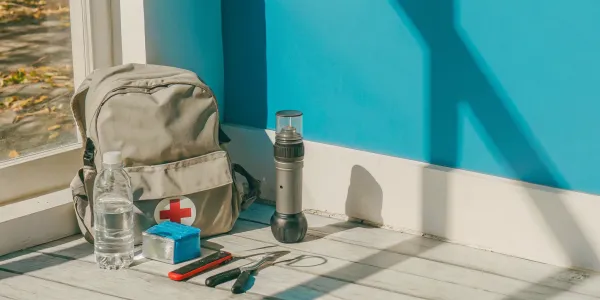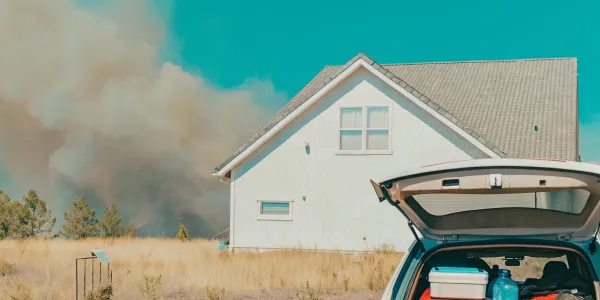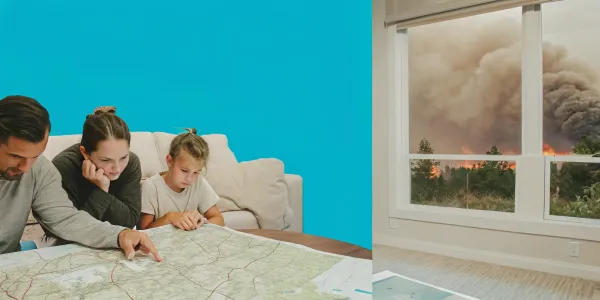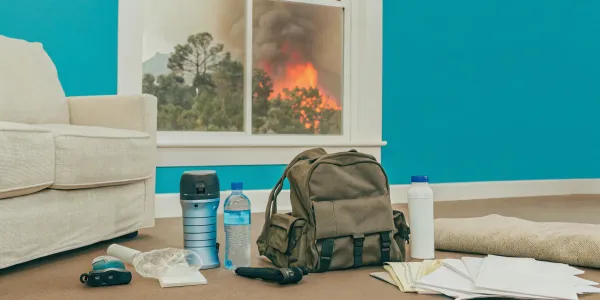5-Minute Evacuation Checklist: What to Grab Now
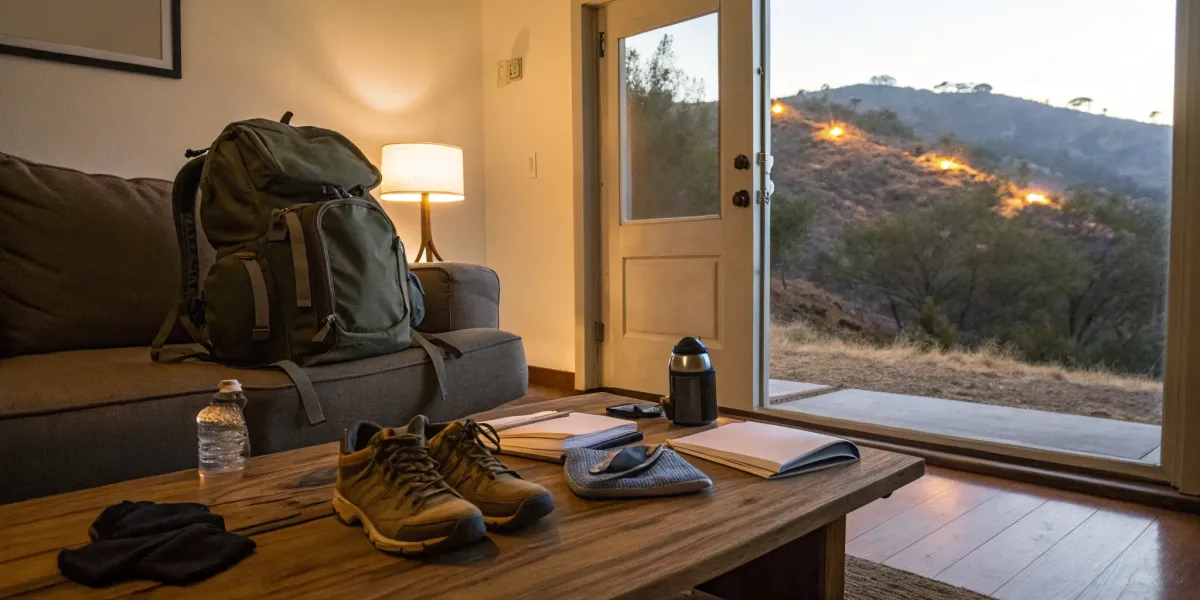
We all remember fire drills from school—the loud bell, the single-file line, the designated meeting spot. We practiced it so that if a real fire ever happened, we could act on instinct. Yet, few of us apply that same logic to our own homes, where the stakes are infinitely higher. An evacuation order is the real-life fire drill you can’t afford to fail. The key is to do the hard thinking now, when you’re calm and rational, so you can move on autopilot when stress and fear take over. This guide will help you create that muscle memory for your family. We’ll show you how to build a simple, actionable plan centered around a 5 minute evacuation list, turning a potentially frantic scramble into an orderly, practiced exit.
Key Takeaways
- Build Your Evacuation System Now: A fast getaway depends on organization, not luck. Centralize all your essentials—Go-Bags, pet carriers, and last-minute items—into a designated "Go-Zone" and create digital backups of your critical documents to ensure nothing is left to chance.
- Map Your Escape Before You Need It: Knowing what to grab is only half the battle. A complete plan includes at least two practiced escape routes, pre-determined family meeting points, and a communication strategy that doesn't rely on local cell service.
- Make Your Plan a Living Document: A plan on paper is useless if it's outdated or unpracticed. Run evacuation drills with your family twice a year to build muscle memory, and schedule an annual review to update supplies, check expiration dates, and confirm your contacts are still current.
Why You Need a 5-Minute Evacuation Plan
When an evacuation order comes, there's no time for debate or careful packing. A 5-minute plan isn't about rushing; it's about having a clear, practiced strategy that gets you and your family to safety without hesitation. It’s your roadmap through the chaos, built during a time of calm so you can execute it under pressure. This section will explain why having this plan is one of the most critical steps you can take to protect what matters most.
Why Every Second Counts
Wildfires move with terrifying speed, and official warnings can come with very little notice. The tragic 2018 Camp Fire in Paradise, California, is a stark reminder that leaving early is essential for survival. Many residents who waited or were unprepared became trapped in traffic, unable to escape the approaching flames. When an evacuation order is issued, it means the danger is immediate. Every second you spend trying to decide what to pack is a second you lose on the road. A pre-made plan helps you leave the moment you get the alert, giving you the best possible chance to avoid congested routes and reach a safe location.
How Preparation Makes a Difference
The middle of a crisis is the worst possible time to make critical decisions. When you’re faced with a direct threat to your home and family, stress and adrenaline make it nearly impossible to think clearly. You might forget essential medications, important documents, or even which way to drive. This is where preparation becomes your greatest asset. By creating a plan ahead of time, you do the hard thinking when you are calm and rational. Your evacuation plan becomes a simple checklist to follow, allowing you to act decisively instead of freezing in panic. You can plan, prepare, and practice simple steps that make leaving your home quicker and safer when it matters most.
Real-Life Evacuation Scenarios
Even emergency preparedness professionals find it difficult to think straight when their own homes are threatened. During the 2017 Santa Rosa fires, one expert shared that despite their training, the overwhelming stress of a potential evacuation made it incredibly hard to decide what to grab. This experience highlights a fundamental truth: no one is immune to the fear and confusion of a disaster. Your brain isn't wired for complex problem-solving under that kind of pressure. That’s why having a physical, practiced plan is so important. It’s not just a list; it’s a tool that helps you overcome your own instincts to panic. A good plan gives you the confidence to act.
What to Grab in 5 Minutes: Your Essential Checklist
When an evacuation order comes, panic can set in, making it hard to think clearly. The key to a safe and orderly departure is knowing exactly what you need before the alert sounds. This checklist breaks down the absolute essentials to grab if you only have a few minutes to leave. Think of this as your script for a high-stress moment. Having these items organized and accessible will help you move quickly and confidently, ensuring you have what’s most important for the road ahead. A detailed Wildfire Action Plan can help you organize these items so you're ready to go at a moment's notice.
Important Documents and IDs
In the chaos of an evacuation, your identity and legal documents are irreplaceable. Keep a designated "Emergency Folder" with originals or copies of your most critical papers. This should include passports, birth certificates, social security cards, and marriage licenses. Also, pack property documents like your home's deed or rental agreement and vehicle titles. Proof of address, such as a recent utility bill, and copies of your insurance policies are vital for filing claims later. These documents are the foundation of your recovery, allowing you to prove your identity, access financial aid, and begin the process of rebuilding after a disaster.
Medications and First-Aid Supplies
Your health can't be put on hold during an emergency. Pack at least a seven-day supply of all essential prescription medications for every member of your family. Don't forget over-the-counter items you rely on, like pain relievers or allergy medicine. Medical necessities such as glasses, contact lenses and solution, hearing aids with extra batteries, or a portable CPAP machine are just as important. A compact first-aid kit is also a must-have for treating minor injuries on the go. Having these items ensures you can manage your health effectively when pharmacies and clinics are out of reach, which is a key part of any emergency preparedness plan.
Phones, Chargers, and Radios
Your cell phone is your primary link to emergency alerts, family members, and evacuation route updates. Make sure every family member grabs their phone and charger. Because power will likely be out, a fully charged portable power bank is one of the most valuable items you can have. Don’t rely on cell networks alone, as they can become overloaded or damaged. Include a battery-powered or hand-crank NOAA weather radio to receive official broadcasts. A bright flashlight with extra batteries is also non-negotiable for navigating in the dark. Staying informed is critical, and these tools are your connection to the outside world.
Basic Survival Gear
While you may be heading to a shelter or a friend’s house, you should be prepared to be self-sufficient for at least 72 hours. Your "Go-Bag" should contain the basics for survival. This includes non-perishable, easy-to-eat food for each person and at least one gallon of water per person, per day. Pack a multi-tool, a whistle to signal for help, and N95 dust masks to protect your lungs from smoke and ash. Having a physical map of the area is also a smart backup in case GPS is unavailable. The federal government provides an excellent checklist for building a kit to ensure you don’t miss anything critical.
Cash, Cards, and Keys
You will need access to money and transportation. Grab your wallet or purse containing your driver's license, credit cards, and debit cards. It's also crucial to have a supply of cash in small bills, as power outages can render credit card machines useless. Don't run out the door without your car keys and house keys. Even if you can't return home immediately, you will need them eventually. Keeping these items together in a designated spot near your Go-Bag can save precious seconds. This financial and logistical readiness is a cornerstone of the quick evacuation tips recommended by fire departments.
Pet Food and Supplies
Your pets are completely dependent on you during an emergency, so they need their own Go-Bag. Pack at least three days' worth of food and water, along with their bowls. Include any medications they take, a leash or harness, and a sturdy carrier for safe transport. It’s also wise to have copies of their vaccination records, as many emergency shelters require them. A current photo of you with your pet can serve as proof of ownership if you become separated. The ASPCA offers a comprehensive guide to disaster preparedness for your pets to ensure your whole family gets to safety.
Create Your Evacuation Strategy
Having your go-bags packed is only half the battle. When an evacuation order comes, chaos can take over. A clear, practiced strategy is what separates a frantic scramble from an orderly departure. This isn’t just about knowing what to grab; it’s about knowing exactly where to go, how to get there, and how you’ll reconnect with your loved ones. Taking the time to build this strategy now gives your family a shared playbook, turning panic into purposeful action when every second is critical. Your plan should be simple, clear, and understood by everyone in your household.
Map Your Evacuation Routes
Don’t wait for an emergency to figure out how to leave your neighborhood. Your first step is to identify at least two different escape routes from your home. GPS and cell service can become unreliable during a disaster, so you need to know these roads by heart. Drive them periodically so you’re familiar with landmarks and potential bottlenecks. Your Wildfire Action Plan can help you visualize these paths in relation to your home’s specific risk. Keep a physical map in your car with these routes highlighted. This simple preparation ensures you can act immediately, even if technology fails you.
Designate a Family Meeting Point
If your family members are separated during an evacuation, you need a pre-determined place to reunite. It’s best to choose two locations. The first should be a spot nearby but out of immediate danger, like a specific tree or a neighbor’s mailbox at the end of the block. This is for sudden events where you have to leave the house instantly. The second meeting point should be outside your neighborhood, such as a library, a relative’s home, or a community center in a nearby town. The American Red Cross emphasizes making this part of your family's emergency plan so everyone knows where to go without needing to communicate.
Set Up a Communication Plan
During a wildfire, local cell towers can get overloaded or damaged. A phone call might not go through, but a text message often can. Your family needs a reliable way to check in. A great strategy is to designate one out-of-state friend or relative as your central point of contact. It’s often easier to make a long-distance call than a local one during a regional emergency. Have everyone in your household call or text this person to report that they are safe. Make sure everyone has this contact’s information saved in their phone and written down in their go-bag.
Plan for Special Needs
Your evacuation plan must account for every member of your household, including children, older adults, individuals with disabilities, and pets. Consider what each person or pet needs to evacuate safely. This could mean packing extra medication, specific foods, hearing aid batteries, or mobility equipment. For pets, have carriers, leashes, and a small supply of food and water ready to go. According to Ready.gov, discussing these specific requirements ahead of time is a critical step in ensuring no one is left behind or without essential supplies during a stressful and time-sensitive evacuation.
Get Your Vehicle Ready
Your car is your most likely ticket to safety, so it needs to be as prepared as you are. During peak fire season, make it a rule to never let your gas tank fall below half-full. You don’t want to be stuck in a long line at the gas station when you need to be leaving. Keep a car-specific emergency kit with water, non-perishable food, jumper cables, and a first-aid kit. The U.S. Fire Administration also recommends keeping your car maintained and parked facing the direction of your primary escape route to save precious time.
How to Organize for a Fast Getaway
When an evacuation order comes, chaos is the enemy. Fumbling for documents, searching for pet carriers, or debating what to pack wastes precious seconds that you simply don't have. A calm, fast getaway isn’t about luck; it’s about organization. By setting up a clear system ahead of time, you replace panic with a plan, ensuring you and your family can leave quickly and safely. This system is your personal command center for an emergency, built around three core ideas: centralizing your supplies, preparing for self-sufficiency, and protecting your identity. It involves creating designated zones for your essentials, packing bags in advance, and securing your most important information. A well-organized strategy is your best defense against the stress and confusion of an emergency. Your personalized Wildfire Action Plan can help you build this system from the ground up, giving you a clear roadmap to follow when time is short. It’s about taking control now so you can act decisively later, turning a potentially frantic moment into a practiced, orderly exit.
The "Go-Zone" System
Think of a "Go-Zone" as your evacuation launchpad. It’s a single, designated spot in your home where all your emergency items are stored. This isn't just about having a Go-Bag; it's about creating a complete system. Start by making an evacuation checklist that prioritizes what you need to take based on how much time you have. Your Go-Zone should contain your pre-packed bags, pet carriers, and a bin for last-minute items like laptops and medications. By centralizing everything, you create a simple, grab-and-go process. When every second matters, you won’t be running around the house—you’ll be heading straight to the one place that has everything you need.
Where to Store Your Essentials
The location of your Go-Zone is critical. The goal is immediate access, so choose a spot along your most likely exit path. A front hall closet, the wall of the garage next to the car door, or a sturdy shelf in your mudroom are all excellent choices. Avoid storing essentials in a basement that could be hard to access or an upstairs bedroom far from an exit. Once you’ve chosen a spot, make sure everyone in your household knows where it is. Walk them through it. This simple step ensures that anyone can grab the Go Bag and other supplies without hesitation, even if you aren't home or are busy with other tasks.
Pack Your Go-Bags Ahead of Time
Your Go-Bags are the core of your evacuation plan and should be packed and ready long before you see smoke on the horizon. Each bag should contain enough supplies to last every member of your family—including pets—for at least 72 hours. This includes water, non-perishable food, a first-aid kit, flashlights, a hand-crank radio, batteries, and any necessary prescription medications. Don’t forget comfort items for children, sturdy shoes for everyone, and extra chargers for your devices. Packing these bags in advance is one of the most empowering steps you can take. It transforms a major, stressful task into a simple action: grabbing the bag and leaving.
Create Digital Backups of Key Documents
In an evacuation, your physical documents are vulnerable to being lost or destroyed. Protecting your essential paperwork is a two-part process. First, place physical copies of birth certificates, passports, social security cards, insurance policies, and property titles in a waterproof, fire-resistant bag inside your Go-Bag. Second, create digital backups as a crucial failsafe. Scan or take clear photos of these documents and save them to a secure cloud service or a password-protected USB drive that you keep with your kit. According to Ready.gov, having copies of important papers is a key part of any emergency kit. This redundancy ensures you can prove your identity and start the recovery process even if the originals are gone.
Practice Your 5-Minute Evacuation
Having a plan on paper is a great first step, but it’s not enough when you hear an evacuation order. In a real emergency, stress and panic can make it hard to think clearly. The key to a calm and effective evacuation is practice. Building muscle memory for your emergency procedures ensures that when every second counts, you and your family can act decisively instead of freezing. This is where your paper plan becomes a life-saving reflex.
Think of it like a fire drill at school or work. The repetition makes the process automatic. Practicing your 5-minute evacuation turns a chaotic scramble into an orderly sequence of actions. It helps you identify weaknesses in your plan—a go-bag that’s too heavy, a document you can’t find, or a pet that refuses to get in its carrier. By working through these issues in a low-stakes drill, you solve problems before they can endanger you during a real wildfire. A well-practiced plan is the foundation of your safety, and your Wildfire Action Plan is the perfect tool to build and refine it. This isn't about achieving perfection; it's about building competence and confidence so that your family can function as a team under pressure. The goal is to make your response so familiar that it feels second nature, freeing up your mental energy to handle unexpected challenges on the road.
Run Family Evacuation Drills
You should practice evacuating your home at least twice a year. Treat it like a serious drill, but maintain a calm tone to avoid frightening children. The goal is to ensure everyone in the household knows exactly what to do, where to go, and what their specific responsibilities are. Walk through the entire process, from grabbing your go-bags to getting in the car and driving your primary evacuation route. Regular practice helps reinforce the evacuation plan and builds confidence, which is your best defense against panic in a crisis.
Tips for a Faster Evacuation
A quick getaway depends on preparation. Decide ahead of time exactly what you will take. This isn't something you want to figure out as smoke fills the air. Your go-bags should contain the absolute essentials, but you may also have a short list of last-minute items to grab, like laptops or precious keepsakes. To make this process easier and support potential insurance claims later, create a home inventory of your belongings. Knowing what’s most important—and where it is—can shave critical minutes off your evacuation time.
Practice Evacuating with Pets
Your pets are part of the family, and they need to be included in your evacuation drills. Animals can sense stress and may hide when they feel scared, making them difficult to find in an emergency. Make sure their carriers are easily accessible and that they have their own go-bags with food, water, medication, and copies of vaccination records. Including them in your drills helps them get used to their carriers and the process of leaving quickly. This familiarity can make all the difference when you need to evacuate safely together.
When to Update Your Plan
An emergency plan is a living document, not a one-and-done task. Your family’s needs change over time, so you should review your kit and update your plan at least once a year. A new baby, a change in medical needs, a new pet, or even kids getting older can all require adjustments to your strategy. Check expiration dates on food, water, and medications in your go-bags. Use this annual review to confirm that your emergency contacts are current and your evacuation routes are still viable. Keeping your plan up-to-date ensures it will be effective when you need it most.
How to Handle Difficult Scenarios
A wildfire evacuation order doesn’t always arrive on a calm, sunny afternoon. The reality is that emergencies are messy and unpredictable. They can happen in the middle of the night, during a storm, or when a family member is sick or injured. A solid evacuation plan is one that holds up under pressure and accounts for these challenging, real-world situations. Thinking through the "what-ifs" now is one of the most powerful things you can do to protect your family.
When you’re disoriented from sleep or dealing with a medical issue, your ability to think clearly and act quickly is compromised. That’s why it’s critical to build solutions for these difficult scenarios directly into your plan. By preparing for the worst-case possibilities, you create a clear path forward, removing guesswork when every second is critical. This section will walk you through planning for some of the toughest evacuation challenges, so you can feel confident that your family is ready for anything. Your Wildfire Action Plan is the perfect place to document these specific strategies.
What to Do for a Nighttime Evacuation
An evacuation order that comes after dark adds layers of stress and disorientation. Your first step is to make your home navigable in the dark. Keep a flashlight and a pair of sturdy, closed-toe shoes next to every bed in your house. You don’t want to be fumbling for essentials when you need to move fast. Designate a single, consistent spot for your keys, wallet, and phone so you can grab them by feel. Most importantly, make sure everybody in the house knows your escape routes and that those paths are always clear of obstacles. Practicing these routes with the lights off can help build the muscle memory needed to get out safely.
Handling Medical Emergencies During an Evacuation
If someone in your household has a medical condition or relies on specific equipment, your evacuation plan needs extra detail. Pack at least a one-week supply of all necessary medications, along with copies of prescriptions, in your go-bag. Include a waterproof document with a list of medical conditions, allergies, doctor contact information, and medication dosages. If you use powered medical devices, have a portable power source or car adapter ready. It’s also wise to discuss your specific needs with your local emergency services office ahead of time; some communities maintain a voluntary registry for those who may require extra assistance during an emergency.
Evacuating with Limited Mobility
For family members with limited mobility, including seniors or those with disabilities, getting out quickly requires a team effort. The first step is to conduct an honest self-assessment of abilities and then establish a support network of trusted neighbors, friends, or family who can help during an evacuation. Ensure your primary and secondary escape routes are clear and accessible for walkers or wheelchairs. Keep all necessary mobility aids near the bed or a main exit. Many local emergency management offices allow you to register for assistance, which alerts first responders that someone in your home may need help evacuating.
Adapting Your Plan for Severe Weather
Wildfires can happen alongside other severe weather events like high winds, which can knock out power, or heavy rain, which can cause mudslides and block roads. Your evacuation plan must be flexible enough to adapt. Map out several evacuation routes in different directions in case your primary path is impassable. Keep waterproof bags or containers handy for your go-bags to protect documents and electronics from rain. Pack rain gear and extra layers of clothing for everyone in the family. A well-practiced plan that accounts for these variables will help you leave your home more quickly and safely, no matter the conditions.
Maintain Your Emergency Plan
Creating an evacuation plan is a huge step, but it’s not a one-and-done task. A plan is only useful if it’s current. Your family’s needs, your supplies, and even your contact information can change over time. Think of your emergency plan as a living document that needs a quick check-up at least once a year. Setting an annual calendar reminder—maybe at the start of fire season or during spring cleaning—is a simple way to ensure your plan is ready when you need it most. This regular maintenance is what turns a good plan into a reliable, life-saving tool.
Update Your List Regularly
Your family isn't static, and your emergency kit shouldn't be either. A new baby, a new pet, or a change in prescription medications all require updates to your go-bags. Take time each year to review your emergency checklist and supplies. Do the clothes still fit your kids? Is the brand of baby formula still correct? Do you have enough supplies for the new dog? An annual review ensures that what you grab in an emergency is what your family actually needs right now. This simple habit keeps your kit relevant and ready for action.
Rotate Your Supplies
The last thing you want to discover during an evacuation is that your emergency food has expired or your flashlight batteries are dead. Many essential items in your kit have a shelf life. Canned goods, water, medications, and batteries all need to be checked and rotated out. Keep your food supplies in a cool, dry place and replace anything past its expiration date. It’s a good practice to build a kit with items you can use and replace in your daily life, ensuring they stay fresh. Test your battery-powered devices and swap in new batteries annually to guarantee they’ll work when the power is out.
Keep Your Insurance Documents Safe
In the chaos of an evacuation, you need your most important documents organized and accessible. This includes insurance policies, birth certificates, passports, social security cards, and property deeds. Having these ready saves critical time and prevents major headaches later when you need to file a claim or prove your identity. Store physical copies in a waterproof, fire-resistant bag in your go-zone. For added security, create digital backups and save them to a secure, password-protected cloud service. This ensures you can access them from anywhere, even if the originals are lost or destroyed.
Manage Your Emergency Contacts
When a disaster strikes, cell service can be unreliable. Your communication plan needs a backup. Review and update your list of emergency contacts, including an out-of-state contact who can act as a central point of communication for your family. Make sure everyone in your household has a physical, printed copy of this list in their go-bag. It’s also crucial to review your designated meeting places and evacuation routes. A comprehensive Wildfire Action Plan helps you organize all these details in one place, so everyone knows the plan without having to second-guess it during a crisis.
Focus on Wildfire: Key Safety Steps
A 5-minute evacuation plan is your last line of defense, but true wildfire preparedness starts long before you smell smoke. For those of us living in high-risk areas, focusing on wildfire-specific safety measures is not just smart—it’s essential for protecting our homes and families. These steps go beyond a simple go-bag; they involve hardening your home, safeguarding your health from smoke, and connecting with your community. By taking these proactive measures, you shift from a reactive mindset to one of control and readiness, giving you and your loved ones the best possible chance of staying safe when a wildfire threatens.
How to Prepare for Fire Season
The time to prepare for fire season is now, not when a plume of smoke appears on the horizon. Start by creating defensible space around your property and considering home hardening upgrades to make your house more resistant to embers. Just as important is your evacuation strategy. As experts at Ready.gov advise, "You may have to evacuate quickly due to a wildfire. Learn your evacuation routes, practice with household, pets and identify where you will go." Map out at least two different escape routes from your neighborhood and designate a meeting spot. To put all these pieces together, you can create a personalized wildfire action plan that outlines every step, from home prep to your family’s evacuation drill.
Protecting Your Lungs from Smoke
Wildfire smoke can travel for hundreds of miles, posing a serious health risk even if you aren't in the direct path of the flames. The fine particles in smoke can damage your lungs and worsen conditions like asthma and heart disease. If you are not ordered to evacuate but the air quality is poor, your best bet is to stay indoors with the windows and doors closed. Use a high-efficiency particulate air (HEPA) filter or a DIY box fan filter to clean the indoor air. You can check local air quality using online tools. If you must go outside, wear a properly fitted N95 or P100 respirator mask to protect your lungs from harmful particles.
Know Your Local Alert Systems
When a wildfire moves quickly, timely information can save your life. Don’t wait for a knock on the door; sign up for your county’s official emergency alerts ahead of time. These systems will send notifications directly to your phone about evacuation warnings and orders. It’s also wise to have multiple ways to receive information, such as a battery-powered or hand-crank NOAA weather radio, in case power or cell service goes out. Trusting official alert systems is critical, as they are managed by authorities who have accurate, up-to-the-minute information on the threat. Make sure every adult in your household is signed up to receive these vital updates.
Find Community Support and Resources
You don’t have to prepare for wildfire alone. In fact, a connected community is a more resilient one. Get to know your neighbors and discuss your emergency plans together. You can identify who might need extra help evacuating, such as elderly residents or families with young children. Many areas have community groups dedicated to wildfire safety, like a local Fire Safe Council, which provides resources and coordinates neighborhood-wide prevention efforts like clearing flammable brush. As FEMA notes, taking time to "plan, prepare and practice" not only helps you but also strengthens your entire community, making it quicker and safer for everyone to leave when an order is issued.
Related Articles
Frequently Asked Questions
Why is a 5-minute plan so important? Can't I just pack when the alert comes?
A 5-minute plan isn't about rushing; it's about having your decisions already made. When an evacuation order is issued, a wildfire is an immediate threat, and the stress of the moment makes it nearly impossible to think clearly. You might forget critical items or waste precious time debating what to take. Having a practiced plan allows you to act on instinct, grabbing what you’ve already decided is essential and getting on the road before traffic builds up.
My go-bags are packed. What's the difference between that and a full evacuation strategy?
Having your go-bags ready is a fantastic and necessary first step, but it's only one piece of the puzzle. A go-bag is what you take, while your evacuation strategy is how you and your family get to safety. A complete strategy includes knowing at least two escape routes by heart, having a designated family meeting point outside your neighborhood, and establishing a communication plan so you can check in with each other if you get separated.
How can I get my family on board with practicing our plan without causing a lot of anxiety?
The key is to frame it as an empowering team activity, not a scary drill. Explain that practicing helps everyone feel more in control and less afraid because you'll all know exactly what to do. Keep the tone calm and positive. You can even make a game out of it for younger kids, like a timed challenge to see how quickly everyone can get to the car with their responsibilities. The goal is to build confidence, not fear.
What if I'm not at home when an evacuation order is issued?
This is a very real possibility, and it’s why your communication plan and designated meeting spots are so critical. If you're at work and your kids are at school, your family needs a clear, pre-arranged plan to reunite. This includes having an out-of-state contact everyone can text or call to check in, as local phone lines may be overwhelmed. Knowing your family has a plan to reconnect provides peace of mind and a clear course of action in a chaotic situation.
Besides my go-bag, what is the most critical thing I should have ready for a nighttime evacuation?
An evacuation order in the middle of the night is disorienting and adds another layer of stress. The simplest and most effective preparation you can make is to keep a flashlight and a pair of sturdy, closed-toe shoes right next to every bed in your house. This ensures that no one is fumbling in the dark or trying to leave in flimsy footwear. It’s a small step that saves critical time and helps you move safely and quickly when you are awakened suddenly.

